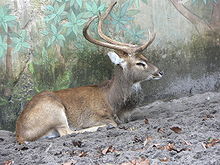Sangai
| Sangai | |
|---|---|
 |
|
| Scientific classification | |
| Kingdom: | Animalia |
| Phylum: | Chordata |
| Class: | Mammalia |
| Order: | Artiodactyla |
| Family: | Cervidae |
| Subfamily: | Cervinae |
| Genus: | Rucervus |
| Species: | R. eldii |
| Subspecies: | R. e. eldii |
| Trinomial name | |
|
Rucervus eldii eldii (M'Clelland, 1842) |
|
The sangai is an endemic, rare and endangered subspecies of brow-antlered deer found only in Manipur, India. It is also state animal of Manipur. Its common English name is Manipur brow-antlered deer and the scientific name, Rucervus eldii eldii McClelland. It lives in the marshy wetland in Keibul Lamjao about 45 km from Imphal. Its habitat is located in the southern parts of the Loktak Lake, which is the largest freshwater lake in eastern India. It is also one of the seven Ramsar sites of international importance. The habitat of the sangai is now protected as the Keibul Lamjao National Park.
The brow-antlered deer or the dancing deer is found in its natural habitat only at Keibul Lamjao National Park over the floating biomass locally called "phumdi" in the south eastern part of Loktak Lake. It is located between 24°27’ N and 24°31’ N latitude and 93°53’ E and 93°55’ E longitudes. The park covers an area of 40 km2. and the home range of the deer in the park is confined to 15–20 km2.
Phumdi is the most important and unique part of the habitat. It is the floating mass of entangled vegetation formed by the accumulation of organic debris and biomass with soil. Its thickness varies from few centimeter to two meters. The humus of phumdi is black in color and very spongy with large number of pores. It floats with 4/5 part under water.
The number of deer listed in the Red Data Book was only 14 in 1975. After the declaration of the area as a national park and with strict conservation measures taken up by the Forest Department, the fear of its extinction has been greatly reduced.
The brow-antlered deer is a medium-sized deer, with uniquely distinctive antlers, measuring 100–110 cm. in length with extremely long brow tine, which form the main beam. The two tines form a continuous curve at right angles to the closely set pedicels. This signifies its name, brow-antlered deer, the forward protruding beam appears to come out from the eyebrow. The antlers of the opposite sides are unsymmetrical with respect to each other. The beams are unbranched initially whereas curvature increases as length increases and they get forked also. The sexes are moderately dimorphic in body size and weight. The height and weight of a fully grown stag may be approximately 115–125 cm at shoulder and 95 to 110 kg (210 to 230 lb) respectively. The height and weight of the female are shorter and less as compared to the male counterpart. The length of the body from the base to the ear up to the tail is about 145 to 155 cm in both sexes. The tail is short and rump patch is not pronounced.
...
Wikipedia

